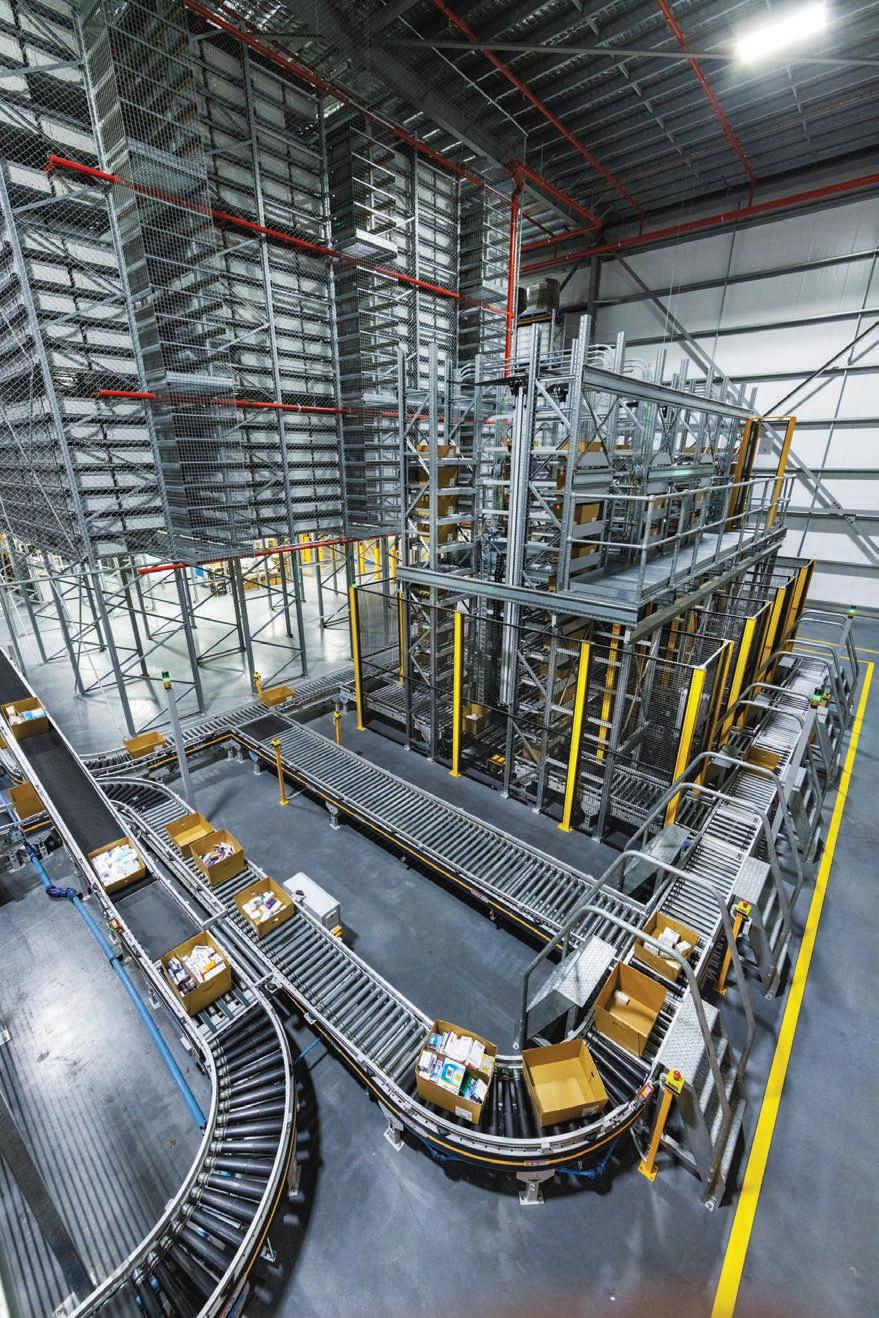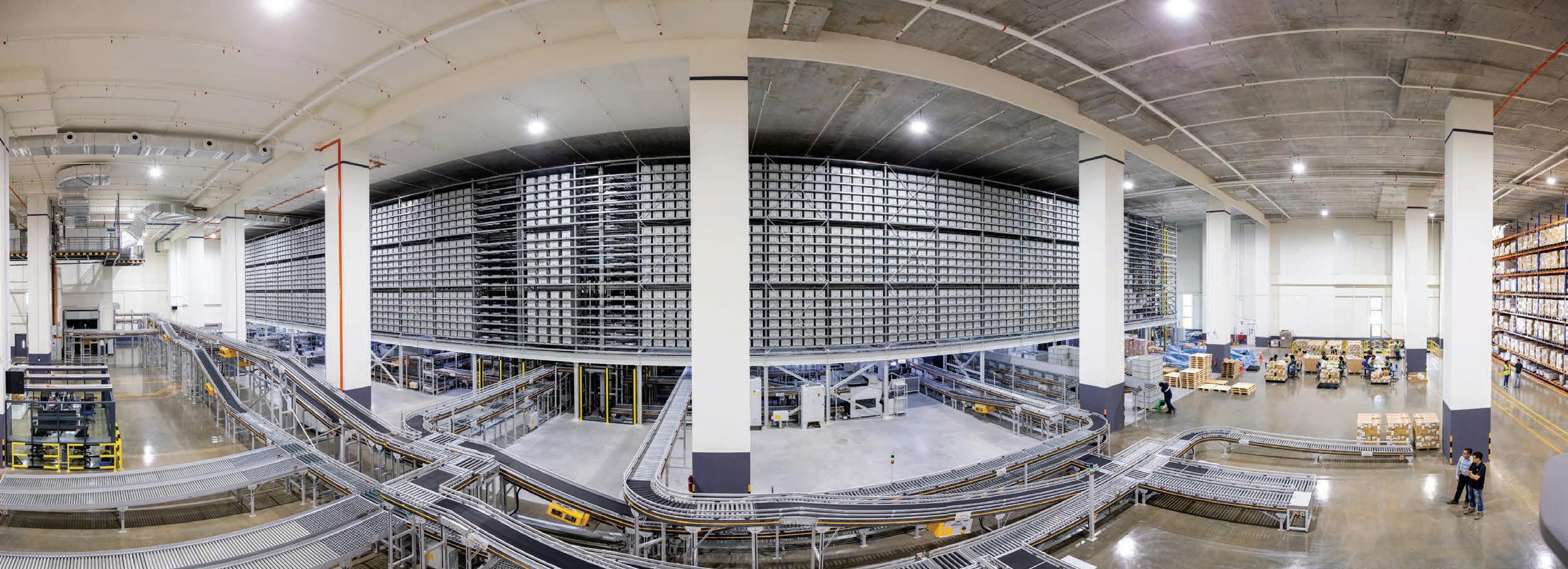
9 minute read
Dematic on optimisation through
OPTIMISATION THROUGH AUTOMATION: A NEW PARADIGM
Dematic has refreshed its approach to optimisation through automation. MHD talks with Dematic’s Pas Tomasiello, Senior Regional Director – Sales & Solutions Development APAC, and Philip Makowski, Marketing Director, Asia Pacific, about the imperatives for automation – and new strategies for distribution success.
Sigma Healthcare turned to automation to help improve service levels in the face of increasing competition.
The name ‘Dematic’ is by this point almost a byword for intelligent automated solutions in the supply chain domain. But, as Pas Tomasiello, Senior Regional Director – Sales & Solutions Development at Dematic APAC, notes – to continue offering the best in automation solutions, Dematic must always renew its own development strategies as well as continue engaging with, educating, and learning from the market.
In other words, new times demand new approaches.
In keeping with this notion, Dematic recently released a new eBook, Automation Strategies for Distribution Success, a deep dive into what it means today to optimise for distribution, the primary imperatives that demand optimisation, and the extensive portfolio of solutions Dematic offers customers and would-be customers regardless of what stage they are at in their respective
At its small parts warehouse, Siemens has been able to get more out of the space with an Autostore small item picking solution.

business and technology journeys.
“This eBook is the crystallisation of an effort we have recently made at Dematic to refresh our go-to-market strategies for optimisation and to educate customers on the meaning and necessity of optimisation today – and how Dematic can best help them,” Pas says.
More than a decade ago, Dematic devised 10 key strategies for optimisation through automation. That set of strategies has served Dematic and its customers well, says Pas, but the strategies themselves needed to be optimised to account for the realities of 2022 and the learnings of recent times.
“Back then, we came up with 10 strategies that really represented a journey for our customers to go from entry levels of automation right through to full automation,” Pas says. “The way we framed it back then was in terms of incremental steps along a journey.
“This time around, we have made a conscious attempt to remove the notion of automation optimisation as a ‘journey’. Assessing the realities of supply chain and distribution today, we no longer think that the idea of a journey – starting small and building higher and higher up – is fit for purpose. The message we’re conveying now is you can start at any point along that journey – and it’s not a one-way path. Today, you can achieve distinct high automation goals by taking on any combination of the solutions Dematic offers.
“It’s no longer the case that you must start by introducing a tiny little bit of technology, and then start adding conveyors, then adding stations, then moving on to full automation. What we are telling customers now is that wherever you are in your journey – we’ll meet you there to tailor the solution you need.” It’s no longer the case that you must start by introducing a tiny little bit of technology, and then start adding conveyors, then adding stations, then moving on to full automation. What we are telling customers now is that wherever you are in your journey – we’ll meet you there to tailor the solution you need. ”
A PARADIGM SHIFT
Pas says the eBook is addressed to new challenges in the logistics and supply chain sector; chiefly: labour availability, changing consumer demand patterns, cost of land pressures, and the ramifications of COVID and the post-COVID era.
“There is a greater sensitivity to the notion that the future is unknown, which is more prominent now than it was pre-COVID,” he says. “Thus, we want to help build resilience and agility into the supply chain. Our customers need help, and they need to know where to take their supply chain and distribution. So, in comes Dematic: Here’s what we’ve got. Talk to us.”
Philip Makowski, Marketing Director, Asia Pacific at Dematic, adds that the release of this eBook was also motivated by the increasing availability of new technologies – especially in the goods-to-person space. “Where once it was necessary to add on layers of automation technology – you couldn’t just install a very sophisticated system right off the bat – now we have customers who are introducing an AutoStore, Multishuttle or Pallet Automated Storage and Retrieval systems as their first step,” Philip says. “That wasn’t always possible.”
Pas says that in supply chain terms COVID inaugurated a new era of thinking. “There was B.C. – before COVID – and after COVID,” he says. “Before COVID everything was ROIbased; it was all about presenting a business case where everything was accounted for and there was a tangible ROI that could be financially modelled.”
He says that after COVID the “intangibles” of supply chain thinking have come dramatically to the fore.
“It introduced measures of return that previously were in the ‘intangibles’ bucket,” Pas says. “It’s no longer just about ROIs and financial returns. Now it’s about the intangibles: building resilience and agility into your supply chain; being adaptable to the unknowns of the future. For me, the imperative to optimise through automation arises from a paradigm shift away from traditional financial modelling and towards a paradigm that puts greater emphasis on preparedness for uncertainty.”
FOUR IMPERATIVES TO OPTIMISE
Dematic’s new strategic perspective for its customers – explored in its new eBook – outlines four primary imperatives that necessitate optimisation with automation:
1. Consumer demands; 2. Labour costs and availability; 3. Rising cost of space; and 4. Dealing with volatility.
CONSUMER DEMANDS
E-commerce has manifestly wrought great and rapid changes to consumer demands and behaviour. Put simply – Pas says consumers now demand higher quality and faster delivery. “And if you mess up an order or it’s late then you’re very likely to lose that customer for good.”
Philip believes we have entered the world of the “empowered consumer” – not only because consumer expectations have risen sharply, but because the range of alternatives is greatly expanded, and there are myriad forms of data available to consumers and accessible at their fingertips.
“Now consumers can ask a series of questions and easily compare and contrast performance with competing offerings,” Philip says. “Who has the best price? Who will get me the product first? Who provides free shipping? Who has the best returns policy? Which vendors make the fewest mistakes? The empowered consumer is more demanding than ever – so to compete in supply chain you need to meet those demands. You need to step up, you need to optimise – and that can only be done through automation.”
LABOUR COSTS AND AVAILABILITY
As Pas notes, a scarcity of labour drives up its cost. The ageing workforce is a “mega-trend” he says has been bearing down on Australia for at least a decade. And as the older generation exits the workforce, it is not being replaced by the newer generations, for whom working in a warehouse is often not an attractive proposition.
Both Pas and Philip believe that successful implementation of automation changes both the profile
Automation has helped Bolloré Logistics reduce its footprint, increase productivity, and cater for omnichannel distribution.
Regardless of what market you’re in, regardless of what industry you’re in, regardless of your order profile, regardless of your customer demands – regardless of all that – Dematic can help with our broad portfolio of products, technology, and solutions. The depth of our portfolio and breadth of experience mean we can help anyone in any industry – no matter their size, big or small. ”

of workers sought by employers and the attractiveness of warehouses for would-be employees. By freeing workers from more mundane routinised tasks, they can engage in more sophisticated work requiring higher order thinking – which means employers will seek intellectually adaptable workers who are at home with technology. Automated warehouses are more attractive workplaces as they move further away from manual labour and towards knowledge work.
With a tight labour market in supply chain and warehousing, optimising through automation means fewer workers are needed – which boosts resilience during seasonal or unexpected fluctuations. “Your problem is radically reduced if you only have to hire five people in a hurry for more attractive jobs versus 50 people for less attractive jobs,” as Pas neatly summarises it.
RISING COST OF SPACE
With the demand for industrial real estate continuing to outstrip supply, automation is essential to optimising land’s productive value. Here as elsewhere, Philip says, automation allows you to get more out of less, with well-orchestrated automation reducing the size of the warehouse footprint.
This consideration is doubly important, he adds, when one considers that e-commerce requires swift delivery and despatch – i.e., a fulfilment centre or warehouse can’t afford to be too far from urban centres.
“Automation means you can optimise the use of every square foot of your facility,” Philip notes. “This means you can get more from less and build on smaller parcels of land that are closer to your customers. Proximity to key population centres means you can leapfrog your competitors, because your delivery window will be faster and smaller.”
DEALING WITH VOLATILITY
Dematic’s new eBook explores the new conditions of volatility and uncertainty in the post-COVID era. Pas and Philip encourage MHD readers to explore its pages to discover various ways in which optimisation through automation can fortify warehouses and fulfilment operations against expected and unexpected shocks.
“In short, automation is unique in the sense that – unlike manual systems – you can easily deal with seasonal volatility,” Philip says. “If you’re hit with labour cost and/or availability issues, automation makes you more resilient to that. If there are spikes in throughput, you’ll be able to deal with those periods much better because you’ll have more capacity and mobility to flex with an automated system.”

ENTERING AUTOMATION WITH DEMATIC
Pas says Dematic is primed, postCOVID, to tackle any challenge with its portfolio of automation solutions.
“The entry point to automation has definitely shifted to a higher level,” he says. “Consider the primary categories in which optimisation can occur – processes, humans, inventory, and data. In the past automation was often thought of in a stepladder-like approach – starting at the lowest point and climbing higher with each successive step. That’s all in the past. Dematic is in perfect position to holistically assess an operation and isolate the best entry point for optimisation. No longer do you have to sort your data and your inventory before adding automation. Now the entry point has shifted such that you can introduce automation at the same time as you deal with inventory and data management and personnel considerations.”
For Dematic, optimising with automation is more flexible and scalable than ever. Not only are there more points of entry, but lower barriers to entry, too. As Pas concludes:
“Regardless of what market you’re in, regardless of what industry you’re in, regardless of your order profile, regardless of your customer demands – regardless of all that – Dematic can help with our broad portfolio of products, technology, and solutions. The depth of our portfolio and breadth of experience mean we can help anyone in any industry – no matter their size, big or small.
“If there’s one key message I’d like readers to take away from this interview and our new eBook, it would be this: We can help you. It’s that simple.” ■










